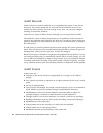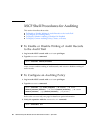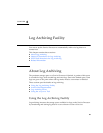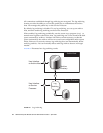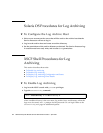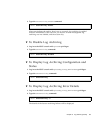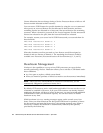
Chapter 6 Log Archiving Facility 71
As shown in FIGURE 6-1,
(1) Before enabling log archiving, create an archive directory on the archive host.
There should be a separate archive directory for each system that uses the archive
host. The directory permissions should be set so that only authorized users can
access its contents.
(2) You configure the log archiving feature.
(3) As new data accumulates in logs, log archiving polls log files at fixed intervals
to determine when new data needs to be archived.
(4) Log archiving uses scp to transfer log data to the archive host. It uses ssh to
manage the logs which it previously copied.
Archive Host Requirements
As the Service Processor keeps track of archive space on the archive host, you should
not store other files in these archive directories.
It is possible to set up the Service Processor so that it uses one of the domains in the
same system as an archive host. However, this configuration does not provide
optimal reliability and serviceability. Typically, a separate, remote server functions as
the archive host.
Log Archiving Errors
The log archiving system handles typical errors by retrying and recording errors in
the Event Log. Possible error causes include archive host downtime, network
outages, and misconfiguration of the Service Processor and/or the archive host. You
can use the showarchiving command to view the details of the last ten archiving
failures, including the first 1000 characters of output from any command that failed.
Using the snapshot Tool
Log data can also be collected and transferred from the Service Processor with the
snapshot command. The snapshot tool does not extend or replace any other
functionality, such as log archiving or logging of information using syslog. Refer to
the snapshot(8) man page for details on this tool.




